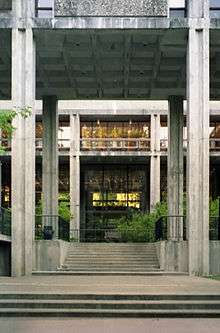Sandra Faber
Sandra Moore Faber (born December 28, 1944) is an astrophysicist known for her research on the evolution of galaxies. She is the University Professor of Astronomy and Astrophysics at the University of California, Santa Cruz, and works at the Lick Observatory. She has made important discoveries linking the brightness of galaxies to the speed of stars within them and was the co-discoverer of the Faber–Jackson relation. Faber was also instrumental in designing the Keck telescopes in Hawaii.
Sandra M. Faber | |
|---|---|
 Sandra Faber accepting the National Medal of Science from President Barack Obama in 2013 | |
| Born | Sandra Moore December 28, 1944 |
| Nationality | American |
| Alma mater | Swarthmore College Harvard University |
| Known for | Faber–Jackson relation, Designing the Keck Observatory |
| Awards | Dannie Heineman Prize for Astrophysics (1985) Bruce Medal (2012) National Medal of Science (2013) Gruber Prize in Cosmology (2017) Magellanic Premium (2018) |
| Scientific career | |
| Fields | Astronomy |
| Institutions | University of California, Santa Cruz Lick Observatory |
| Thesis | Photometry of elliptical galaxies in multiple systems (1971) |
| Doctoral advisor | I. John Danziger |
| Doctoral students | Tod R. Lauer |
Early life and education
Faber studied at Swarthmore College, majoring in Physics and minoring in Mathematics and Astronomy. She earned her bachelor's degree in 1966. She then earned her Ph.D. in 1972 from Harvard University, specializing in Optical Observational Astronomy under the direction of I. John Danziger.[1][2] During this time the only observatory open to her was the Kitt Peak National Observatory, which had inadequate technology for the complexity of her thesis.
Personal life
Faber married Andrew Leigh Faber, a fellow Swarthmore physics major one year her junior, on June 9, 1967. They have two daughters, Robin and Holly.[3]
Career and research
In 1972, Faber joined the faculty of the Lick Observatory at University of California, Santa Cruz, becoming the first woman on staff.[1] In 1976, Faber observed the relationship between the brightness and spectra of galaxies and the orbital speeds and motions of the stars within them. The law that resulted would become known as the Faber-Jackson relation, after herself and the co-author, graduate student Robert Jackson. Three years later, she and collaborator John S. Gallagher published a seminal paper collecting all of the evidence for the existence of dark matter that had been published at that point. In 1983, she published original research showing that dark matter was not composed of fast-moving neutrinos ("hot dark matter") and that instead, it was likely composed of slow-moving particles yet to be discovered ("cold dark matter").[4]
Around 1984, Faber collaborated with Joel Primack, George Blumenthal, and Martin Rees to elucidate their theory of how dark matter was part of galaxy formation and evolution.[5] This was the first proposal of how galaxies have formed and evolved from the Big Bang to today. While some details have been proven wrong, the paper still stands as the current working paradigm for structure information in the universe. She and her collaborators discovered high-speed galaxy flows.[1]
In 1985, Faber was involved with the construction of the Keck Telescope and building the first wide-field planetary camera for the Hubble Space Telescope. UC Berkeley physicist Jerry Nelson designed the Keck telescope, but Faber helped to sell the idea of large optical telescopes all over the world. The Keck telescope is the second largest optical telescope in the world, with a 10-meter primary mirror of a novel type that consists of 36 hexagonal segments.
Sandra Faber co-chaired the Science Steering Committee, which oversaw the first-light instrument for Keck I. She also continued to insist on high optical quality for the primary mirror of the Keck I, and went on to work on the Keck II as well.
During the later 1980s, Faber got involved in an eight-year project called the "Seven Samurai" collaboration, which attempted to catalogue the size and orbital speeds of 400 galaxies. Though this goal was not met, the group developed a way to estimate the distance to any galaxy, which became one of the most reliable ways to measure the total density of the universe.
In 1990, she assisted with the on-orbit commissioning of the wide field planetary camera for the Hubble Space Telescope. She lists this as one of the most exhilarating and well-known phases of her career. The optics of the Hubble were flawed, and Faber and her team helped to diagnose the cause as spherical aberration.[6] In 1995, Faber was appointed University Professor at UCSC.[1]
Faber was also the principal investigator of the Nuker Team, which used the Hubble Space Telescope to search for supermassive black holes at the centers of galaxies.[1] One of her most recent works include the addition of a new optical spectrograph for the Keck II telescope, which saw its first light in 1996. The new addition would increase the Keck II's power for observing far-away galaxies by 13-fold. She has also joined up with other scientists to create the CANDELS project, which is the largest survey of the universe taken by the Hubble Telescope.[7]
At UCSC she focuses her research on the evolution of structure in the universe and the evolution and formation of galaxies. In addition to this, she led the development of the DEIMOS instrument on the Keck telescopes to obtain spectra of cosmologically distant galaxies. On August 1, 2012 she became the Interim Director of the University of California Observatories.[1]
Sandra Faber is co-editor of the Annual Review of Astronomy and Astrophysics.
Honors and awards
- Bart J. Bok Prize, Harvard University (1978)[1]
- National Academy of Sciences (elected 1985)
- Dannie Heineman Prize for Astrophysics (1985)[8][9]
- American Philosophical Society (elected 2001)
- Harvard Centennial Medal (2006)
- Bower Award and Prize for Achievement in Science, Franklin Institute (2009)[8][1]
- Henry Norris Russell Lectureship, American Astronomical Society (2011)[8]
- Bruce Medal, Astronomical Society of the Pacific (2012)[8]
- Karl Schwarzschild Medal, German Astronomical Society (2012)[8]
- National Medal of Science (2012)[8][10]
- Gruber Prize in Cosmology (2017)[8][11]
- Annette de Vaucouleurs Medal, University of Texas
- Medaille de l'Institute d'Astrophysique de Paris
- Alfred P. Sloan Foundation Fellow
- Honorary Doctorates from the University of Chicago, University of Michigan, University of Pennsylvania, Swarthmore College, and Williams College [12][13]
- Member, American Academy of Arts and Sciences
- Member, Harvard Board of Overseers
- Member, Board of Trustees of the Carnegie Institution for Science
Minor planet #283277 Faber is named for her.[8]
See also
- Faber-Jackson relation
- Nuker Team
- Hubble Space Telescope
References
- Stephens, Tim; 459-2495, Staff Writer. "Astronomer Sandra Faber to receive Franklin Institute's prestigious Bower Award". UC Santa Cruz News. Retrieved 2017-07-08.CS1 maint: numeric names: authors list (link)
- Faber, Sandra Moore (1972). Photometry of elliptical galaxies in multiple systems (Ph.D.). Harvard University. OCLC 976673998 – via ProQuest.
- "Sandra Moore Faber".
- "Sandra Faber Receives $500,000 Gruber Cosmology Prize | American Astronomical Society". aas.org. Retrieved 2017-07-08.
- Blumenthal; et al. (11 Oct 1984). "Formation of galaxies and large-scale structure with cold dark matter". Nature. 311 (5986): 517–525. Bibcode:1984Natur.311..517B. doi:10.1038/311517a0.
- Faber, S. (1995, July 12). Autobiographical Sketch: Sandra M Faber. Retrieved November 14, 2015, from http://cwp.library.ucla.edu/articles/faber.htm
- Sandra Faber Honored By American Astronomical Society. (2011, January 18). Retrieved November 14, 2015, from http://search.proquest.com/docview/848222994
- "The Bruce Medalists: Sandra M. Faber". www.phys-astro.sonoma.edu. Retrieved 2017-07-08.
- "Faber Receives Heineman Prize for Work in Astrophysics". Physics Today. 39 (3): 119. 2008-01-08. doi:10.1063/1.2814940.
- Burns, J. (2012, December 12). UCSC astronomer Sandra Faber to receive the National Medal of Science. Retrieved November 24, 2015, from http://news.ucsc.edu/2012/12/national-science-medal.html
- "2017 Gruber Cosmology Prize Press Release | The Gruber Foundation". gruber.yale.edu. Retrieved 2017-07-08.
- Peter H Bodenheimer. (n.d.). Retrieved November 14, 2015, from http://www.astro.ucsc.edu/faculty/profiles/singleton.php?singleton=true&cruz_id=smfaber%5B%5D
- Where Are You From? - Credo Reference. (n.d.). Retrieved November 14, 2015, from http://search.credoreference.com/content/entry/marquisworld/faber_sandra_moore/0?searchId=d87354e9-6254-11e5-b2c4-0aea1e3b2a47&result=0
Further reading
- Lemonick, Michael D. (1993). The light at the edge of the universe : leading cosmologists on the brink of a scientific revolution (1st ed.). New York: Villard Books. ISBN 978-0679413042.
External links
- Dr. Faber's page @ UCSC
- See video of Dr. Faber @ Meta-Library.net
- UC Santa Cruz's biography of Sandra Faber
- Video of Faber explaining How Galaxies Were Cooked from the Primordial Soup on YouTube, from the Silicon Valley Astronomy Lectures
- Oral History interview transcript with Sandra M. Faber 31 July 2002, American Institute of Physics, Niels Bohr Library and Archives
- Video of Faber talking about her work, from the National Science & Technology Medals Foundation
- Photographs of Sandra Faber from the UC Santa Cruz Library's Digital Collections
